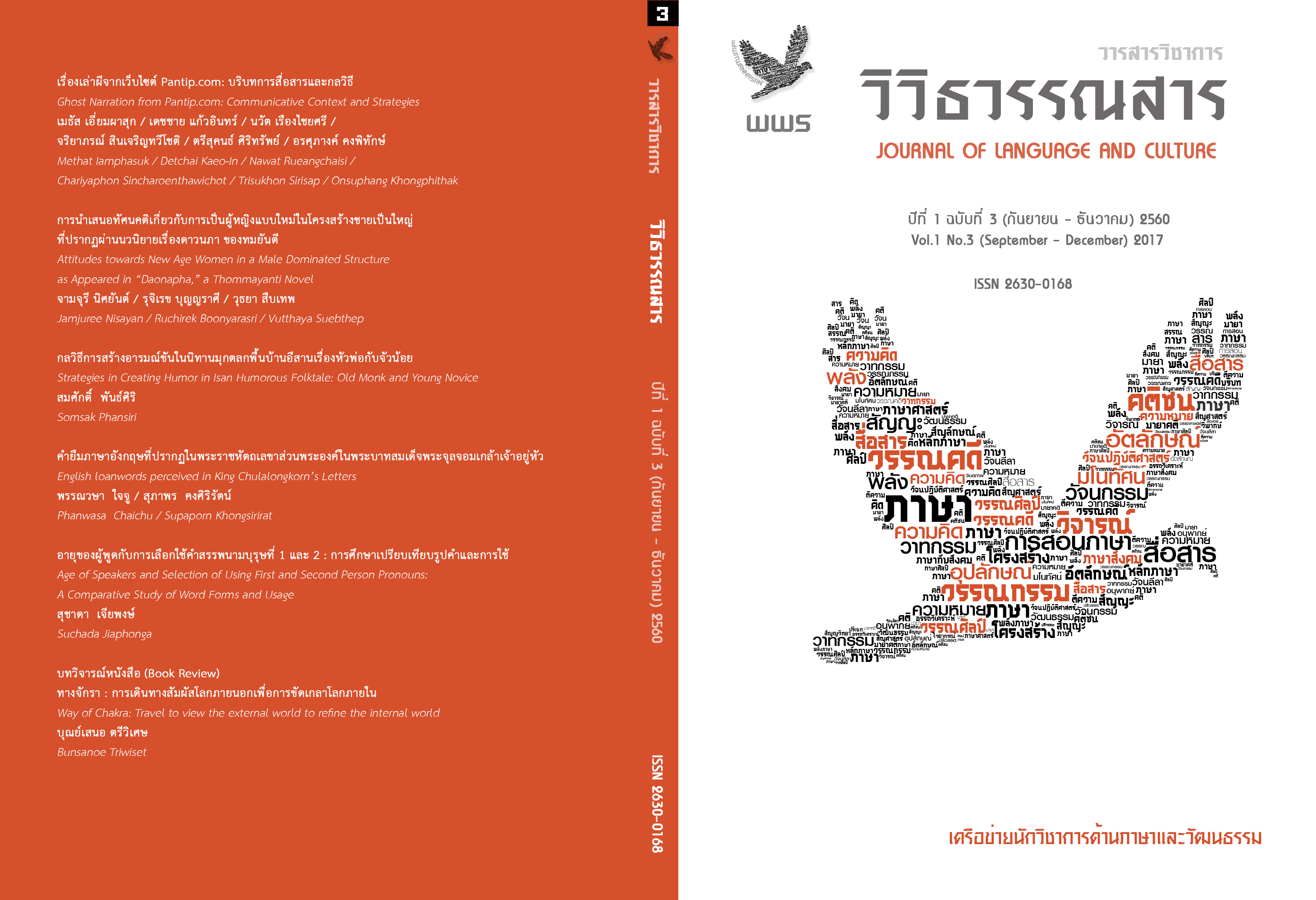เรื่องเล่าผีจากเว็บไซต์ Pantip.com: บริบทการสื่อสารและกลวิธี
Main Article Content
บทคัดย่อ
บทความวิจัยนี้มีวัตถุประสงค์เพื่อศึกษาบริบทการสื่อสารและกลวิธีทางภาษาที่ใช้ในการเล่าเรื่องผีจากเว็บไซต์ Pantip.com ในแท็กเรื่องเล่าสยองขวัญ โดยเก็บรวบรวมข้อมูลจากกระทู้ที่มีจำนวนการแสดงความคิดเห็นตั้งแต่ 100 ความคิดเห็นขึ้นไป ระหว่างเดือนมกราคม-สิงหาคม พ.ศ.2559 ทั้งหมด 7 กระทู้ ผลการวิจัยพบว่า บริบทการสื่อสารเรื่องเล่าผีจากเว็บไซต์ Pantip.com คือพื้นที่ที่เปิดโอกาสให้ผู้ที่สนใจเรื่องเล่าเกี่ยวกับผีสามารถเข้ามาสื่อสารหรือมีปฏิสัมพันธ์ระหว่างกันได้โดยที่ไม่ต้องเปิดเผยตัวตน มีจุดมุ่งหมายเพื่อบอกเล่าเรื่องราวเกี่ยวกับผี แลกเปลี่ยนความคิดเห็น ให้คติเตือนใจและให้ความบันเทิงแก่ผู้อ่าน การลำดับ วัจนกรรมของเรื่องเล่าผีในเว็บไซต์ทำให้เห็นว่า เรื่องเล่าผีจะมีการเรียงลำดับเหตุการณ์การสื่อสารทั้งหมด 6 สถานการณ์ และมีการใช้น้ำเสียงที่ทำให้เรื่องเล่าผีเหล่านั้นสามารถสร้างความคิดความเชื่อ ความรู้สึกกลัว เเละสร้างอรรถรสให้แก่ผู้อ่านได้ โดยไม่มีข้อจำกัดเรื่องของเวลาและสถานที่ ส่วนผลการวิเคราะห์กลวิธีทางภาษาพบว่า ผู้เล่าเรื่องผีในเว็บไซต์ Pantip.com ใช้กลวิธีทางภาษาทั้งหมด 6 กลวิธี ได้แก่ 1) การเลือกใช้คำศัพท์ 2) การใช้สรรพนามแทนตัวผู้เล่า 3) การขยายความ 4) การใช้มูลบท 5) การกล่าว เกินจริง และ 6) การกล่าวอ้าง กลวิธีทางภาษาดังกล่าวเป็นกลวิธีที่ทำให้เรื่องผีมีความสมจริง สามารถทำให้ผู้อ่านเกิดจินตนาการและเชื่อว่าเรื่องผีที่เล่านั้นเป็นเรื่องจริงชวนให้ติดตาม นอกจากนี้เว็บไซต์ Pantip.com ยังเปรียบเสมือนชุมชนที่สามารถเข้ามาแลกเปลี่ยนความคิดเห็นหรือแลกเปลี่ยนประสบการณ์ได้อย่างเสรีซึ่งเป็นการผลิตซ้ำความเชื่อเรื่องผีให้คงอยู่ในสังคมวัฒนธรรมไทยต่อไป
Article Details
ลิขสิทธิ์ของบทความเป็นของวารสาร การพิมพ์ซ้ำจะต้องได้ร้บการอนุญาตจากบรรณาธิการวารสาร
เอกสารอ้างอิง
Thammasat University Press.
Anonymous. (2015). 10 wep yot hit khon thai poet boi thi sut. (in Thai). [Top10 Web That
Most of Thai People Access]. Retrieved from
http://www.alexa.com/topsites/countries/TH, 18 September 2016
Aramsuge, S. (2008). Kon la withi kan khian phuea nom naw chai nai
kho lam muat fae chun. (in Thai). [Persuasive Devices in Fasion Columns in SPICY
Magazine in The Year 2006]. Master's Thesis (Thai), Chulalongkorn University.
Aungkanawin, M. (2004). Paritchet sarakhadi nai anusan Or.So.Tho. (in Thai). [Discourse of
Travelogues in TAT Magazine]. Master's Thesis (Thai), Chulalongkorn University.
Bunmalert, P. (2011). Kham riak phi lae khwam chuea rueang phi nai phasa Thai
thin nuea nai mu ban Pa Sao Luang Tambon San Pu Loei, Amphoe Doi Saket,
Changwat Chiang Mai, (in Thai). [Spirit Terms and Beliefs in Northern Thai Dialect of
Muban Pa Sao Luang, Tambon San Pu Loei, Amphoe Doi Saket, Changwat Chiang Mai].
Master's thesis (Thai), Chiangmai University.
Chaithongsri, J. (2001). Kan sueksa priapthiap khwam cheua phi pu ta phak isan lae
khwam cheua phi ta yai phak tai. (in Thai). [The Comparative Study of The Belief in
Phi Pu-Ta in The North east and Phi Ta-Yai in The South of Thailand]. Master's thesis
(Thai Studies), Ramkhamhaeng University.
Diphadung, S. (2009). Watchanapatibatsat bueangton. (in Thai). [Introduction to
Pragmatics].(2nd edition). Nakornpathom: Research Institute of Languages and Cultures
for Rural Development, Mahidol University.
Kaewjungate, W. (2010). Udomkan khwarm pen chai nai wathakam
khotsana sin kha lae borikan samrap phu chai nai nittayasan phu chai. (in Thai).
[The ideology of Masculinity in Men's Advertising Discourse in Men's Magazines]. Master's
thesis (Thai), Chulalongkorn University.
Hengsuwan, M. (2007). Kham riak praphet phi khong khon Thai nai chum chon wat
Suan Kaew, Tambon Bang Len, Amphoe Bang Yai, Chang wat Nonthaburi: Kan
sueksa tam naeo atthasat chattiphan. (in Thai). [Terms for Spirits of The Thais in
Wat Suan Kaew Community, Tambon Bang Len, Amphoe Bang Yai, Nonthaburi: An
Ethnosemantics study]. Master's thesis (Linguistics), Chulalongkorn University.
Hymes, D. (1974). Foundation of Sociolinguistics: An Ethnographic Approach.
Philadelphia: University of Pennsylvania Press.
Labov.W. (1972). The Transformation of Experience in Narrative Syntax.
In Language in the Inner City. Philadelphia: University of Pennsylvania Press.
Parichartthanakul, B. (2003). Khwam cheua reung phi nai phitikam khong chao Thai
Song ฺBan Phai Hu Chang, Amphoe Bang Len, Changwat Nakhonpathom. (in Thai).
[Ritualistic Belief in Ghost of Thai Song, Ban Phai Hu Chang, Amphoe Bang Len,
Changwat Nakhonpathom]. Master's thesis (Thai Studies), Ramkhamhaeng University.
Pinkhanngern, W. (1972). Khwam pen ma khong manutsayachat. (in Thai). [Humanities
Background]. Bangkok: Rungrotkarnphim.
Prasithrathsint, A. (2013). Phasasat sangkhom. (in Thai) [Sociolinguistics]. (5th Edition).
Bangkok: Chulalongkorn University Press.
Rakmanee, S. (2008). Phasa wannasin. (in Thai). [Literary Language]. Bangkok: Sajnamjai.
Royal Institute. (2013). Photchananukrom chabup ratcha bandittayasathan
phutthasakkarat 2554. (in Thai). [Royal Institute Dictionary B.E. 2554]. Bangkok:
Nanmebooks publication.
_______. (2013). Photchananukrom phasasat (phasasat prayuk). (in Thai). [Dictionary of
Linguistics (Applied Linguistics)]. Bangkok: Royal Institute.
Vongvirulh, S. (2004). Kan wang khrong rueang nai paritchet rueang lao chak prasopkan
trong lae prasopkan om nai phasa Thai. (in Thai). [Plot Organization in Thai
Narrative Discourse Based on Direct and Indirect Experience]. Master's thesis (Linguistics),
Chulalongkorn University.
Worrasetrthasak, J. (2005). Kan sueksa wikhro lao rueang sayong khwan khong rai kan
witthayu ‘The Shock’. (in Thai). [An Analysis of Horror Story-Telling on Radio Program
‘The Shock’]. Master's thesis (Thai Language for Business Communication), University of
Thai Chamber of Commerce.


